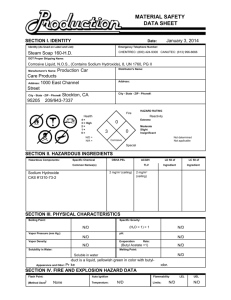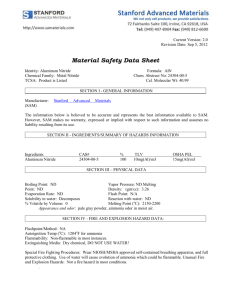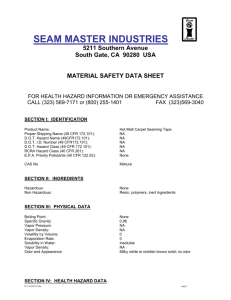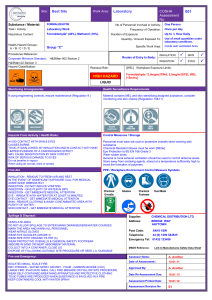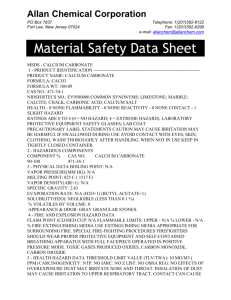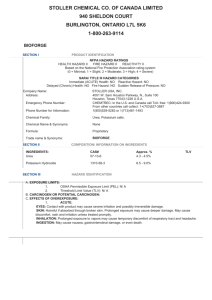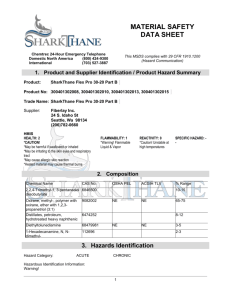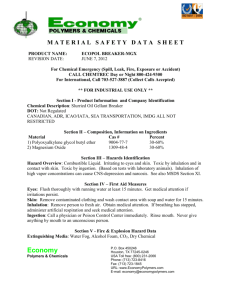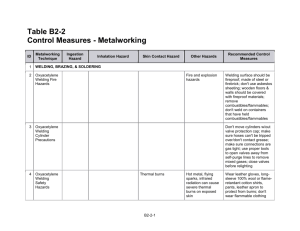v-seal conditioner
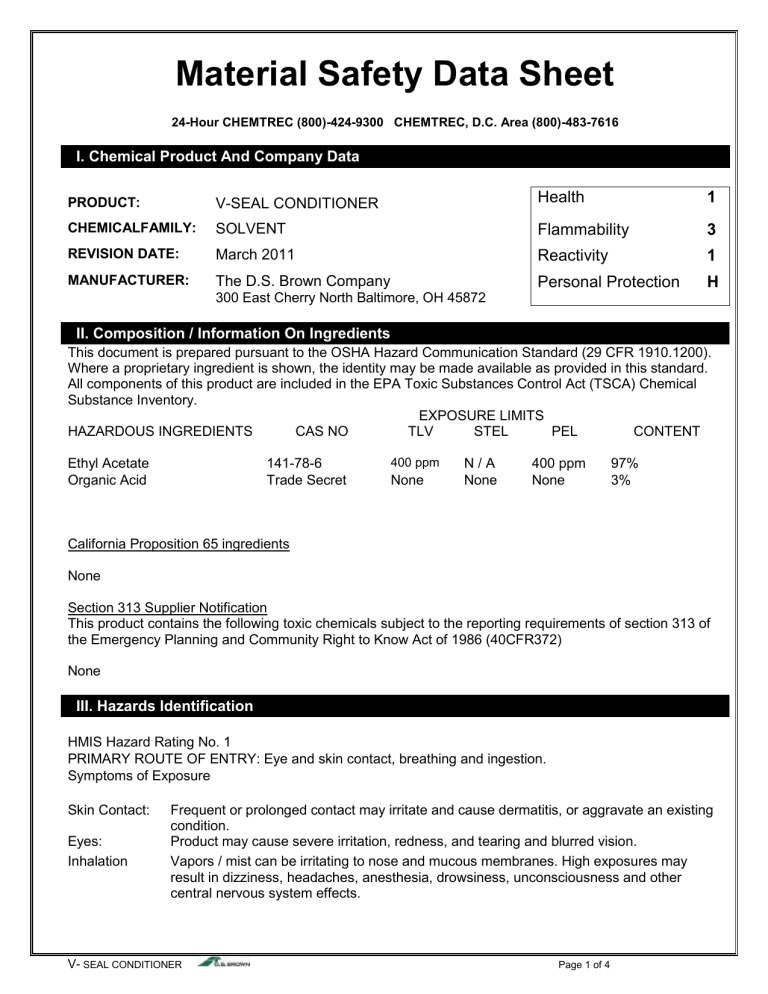
Material Safety Data Sheet
24-Hour CHEMTREC (800)-424-9300 CHEMTREC, D.C. Area (800)-483-7616
I. Chemical Product And Company Data
PRODUCT:
CHEMICALFAMILY:
REVISION DATE:
V-SEAL CONDITIONER
SOLVENT
March 2011
Health
Flammability
Reactivity
1
3
1
MANUFACTURER:
The D.S. Brown Company
300 East Cherry North Baltimore, OH 45872
Personal Protection
H
II. Composition / Information On Ingredients
This document is prepared pursuant to the OSHA Hazard Communication Standard (29 CFR 1910.1200).
Where a proprietary ingredient is shown, the identity may be made available as provided in this standard.
All components of this product are included in the EPA Toxic Substances Control Act (TSCA) Chemical
Substance Inventory.
HAZARDOUS INGREDIENTS
Ethyl Acetate
CAS NO
141-78-6
EXPOSURE LIMITS
TLV
400 ppm
STEL
N / A
PEL CONTENT
400 ppm 97%
Organic Acid Trade Secret None None None 3%
California Proposition 65 ingredients
None
Section 313 Supplier Notification
This product contains the following toxic chemicals subject to the reporting requirements of section 313 of the Emergency Planning and Community Right to Know Act of 1986 (40CFR372)
None
III. Hazards Identification
HMIS Hazard Rating No. 1
PRIMARY ROUTE OF ENTRY: Eye and skin contact, breathing and ingestion.
Symptoms of Exposure
Skin Contact: Frequent or prolonged contact may irritate and cause dermatitis, or aggravate an existing condition.
Eyes: Product may cause severe irritation, redness, and tearing and blurred vision.
Inhalation Vapors / mist can be irritating to nose and mucous membranes. High exposures may result in dizziness, headaches, anesthesia, drowsiness, unconsciousness and other central nervous system effects.
V SEAL CONDITIONER Page 1 of 4
Ingestion: Not expected to be a relevant route of exposure although it may cause permanent damage to the mouth throat and stomach.
IV. First Aid Measures
Inhalation
Eyes
Skin
Ingestion
Remove victim from exposure. If difficulty with breathing, administer oxygen and seek medical assistance
Flush eyes with cold water for a minimum of 15 minutes, lifting lower and upper eye lids throughout. Seek immediate medical attention.
Immediately remove contaminated clothing. Wash thoroughly with soap and water. If irritation persists seek medical attention. Wash contaminated clothing before reuse.
Do not induce vomiting, get immediate medical attention, if vomiting occurs spontaneously keep head below hips to prevent aspiration of liquids into lungs. Do not give anything by mouth to an unconscious person
V. Fire Fighting Methods
HMIS Hazard Rating No. 3
Flash Point: 26 o F
General Hazard: Decomposition and combustion products may be toxic.
Auto-Ignition Temp.: 800 o F
Limits of Flammability
Extinguishing Media
LEL: 2.2% UEL: 11%
For small fires, use water spray, foam, CO2, or dry chemical. For large fires, use water spray, or fog.
Special Fire & Unusual Hazards Move containers from area if it can be done without risk. Cool fireexposed containers with water from the side. As in any fire, wear
NIOSH/MSHA approved; pressure demand self-contained breathing apparatus and full protective gear.
VI. Accidental Release Measures
Action To Take For Spills/ Leaks: Avoid contact with skin or eyes. Ventilate area, and eliminate all sources of ignition. Wear appropriate protective gear, contain leak or spill, salvage, clean up residue with absorbent material.
Waste Disposal Method: Handle disposal of waste material in manner that complies with local, state, province and federal regulation. Landfill if solidified, or incineration at agency approved waste-disposal facilities.
VII. Handling And Storage
Average Shelf Life: Refer to Product Data Sheet
Special Instructions Store away from heat, open flame, sparks. Use proper grounding for bulk quantities.
VIII. Exposure Controls / Personal Protection
Ventilation: Ventilation is recommended. Air movement must be designed to insure turnover at all locations in work area to avoid build up of heavy vapors.
Personal Protection Equipment: Do NOT wear contact lenses when working with this material. Use chemical goggles/safety glasses with side shields and impervious gloves. Wear clothing with long sleeves and pants. In operations where mists can be generated or the exposure limits for crystalline silica exceeded, wear a NIOSH/MSHA approved dust/fume respirator selected by a technically qualified person for the specific work conditions. Wear respirator protection whenever airborne concentrations exceed TLV ceilings or TWA, use NIOSH approved respirators for listed hazard.
V SEAL CONDITIONER Page 2 of 4
Confined spaces, room, or tanks are areas where concern for TLV’s is especially important. Reference
OSHA regulation CFR 29 1910.134 for recommended respiratory protection.
IX. Physical And Chemical Properties
Boiling Point ( o C): 76.5
VOC Content g/l:
Freezing Point ( o C):
875 g/l
-84
Vapor Pressure @ 20 o C N/A
Vapor Density
Odor Threshold:
3.4
N/A
Appearance:
N/A = Not Available
Clear liquid
N/D=NOT Determined
Water/Oil Distribution
Coefficient:
Solubility in Water:
Specific Gravity @20° C
pH:
Evaporation Rate:
Odor:
Ca. = Approximate
N/A
Slight
0.9
N/A
N/A
Fruity
X. Stability And Reactivity
HMIS Hazard Rating No. 1
Stability
Incompatibility:
Stable
Strong bases, and oxidizing agents.
Hazardous Decomposition Products Oxides of Carbon; aldehydes; Decomposition and Combustion products may be toxic.
Conditions To Avoid Strong bases in bulk.
XI. Toxicity Information
HMIS Hazard Rating No. 1
PRIMARY ROUTE OF ENTRY: Inhalation, dermal
Effects Of Overexposure
Skin Contact:
Eyes:
Inhalation
Ingestion:
Frequent or prolonged contact may irritate and cause dermatitis, or aggravate an existing condition.
Product may cause severe irritation, redness, and tearing and blurred vision.
Vapors / mist can be irritating to nose and mucous membranes. High exposures may result in dizziness, headaches, anesthesia, drowsiness, unconsciousness and other central nervous system effects.
Not expected to be a relevant route of exposure although it may cause permanent damage to the mouth throat and stomach.
XII. Ecological Information
Marine Pollutant: NL
(NL = Not Listed; P = Moderate; PP = Severe; ND = Not Determined)
XIII. Disposal Considerations
Handle disposal of waste material in a manner that complies with all applicable local, state, provincial and federal regulations.
V SEAL CONDITIONER Page 3 of 4
XIV. Transport Information
DOT SHIPPING INFORMATON
Shipping Name Flammable Liquid N.O.S (Ethyl Acetate)
Hazard Class
Identification Number
3
UN1993 Packaging Group
XV. Regulatory Information
OSHA Hazard Communication Standard
(29 CFR 1910.1200)
CERCLA/ Super fund (40 CFR 117,302)
N/A
N/A
N/A SARA Extremely Hazardous Substances
(40 CFR 355)
SARA Hazard Categories (40 CFR 370)
SARA Toxic Chemicals (40 CFR 372)
Inventory Status
II
Physical: Fire
None
The chemicals in this product are listed on the US
TSCA Chemical Substance Inventory and the
Canadian Domestic Substances List.
XVI. Other Information
THE INFORMATION HEREIN HAS BEEN COMPLIED FROM SOURCES BELIEVED TO BE RELIABLE
AND IS ACCURATE TO THE BEST OF OUR KNOWLEDGE. HOWEVER, THE D.S. BROWN COMPANY
CANNOT GIVE ANY GUARANTEES REGARDING INFORMATION FROM OTHER SOURCES, AND
EXPRESSLY DOES NOT MAKE ANY WARRANTIES, NOR ASSUMES ANY LIABILITY, FOR ITS USE.
V SEAL CONDITIONER Page 4 of 4
